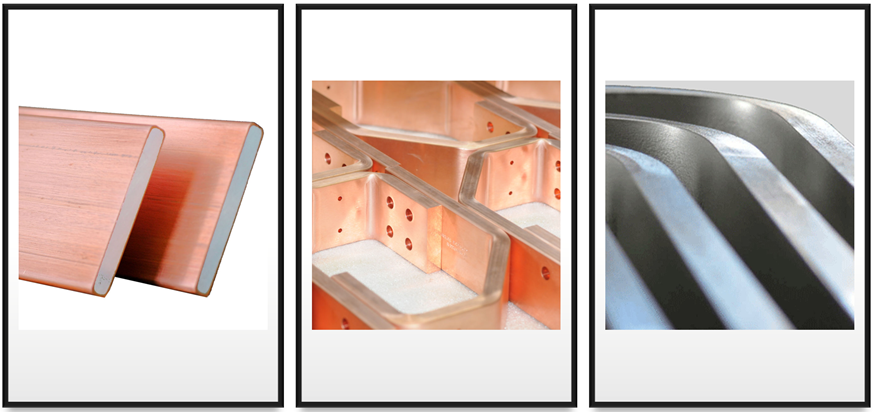
Promet supplies busbars in various materials. In this article we compare the materials and give tips to make the right choice.
Copper
- Traditional material for electro technical applications has excellent electrical properties
- ETP copper is used when a high electrical conductivity is required. ETP copper contains oxygen, so no requirements can be set with respect to brazing and weldability
- OFE copper is a highly pure, not deoxidized and oxygen-free copper, which has a high electrical and thermal conductivity. OFE copper can be very well brazed and soldered and welded.
- High market availability -> volatility is higher than that of aluminum
- In general, copper can be mechanically processed very well
Surface Coating
Due to corrosion (e.g. oxidation), an impurity layer is formed on the contact surface, which increases the resistance. An impurity layer resistance disturbs, especially at very low voltages.
In order to reduce the contact resistance at connection contacts, impurity layers can or must be removed before the connection. Ideally, such contact surfaces are refined.
We can offer the following coating options for this material:
- Tin
- Nickel
- Silver
Aluminium (EN 6101B-T6)
- Is increasingly used in electrical applications
- Alloy is hard, which has a positive impact on the flow properties of the aluminum
- Contact resistance is still very good compared to other aluminum alloys
- Because of the high degree of hardness, it is more challenging for mechanical processing, especially when bending with small radii. Promet has developed a process by which the same radii can be used as for copper busbars
- Availability of the aluminum alloy is limited
Surface Coating
Due to corrosion (e.g. oxidation), an impurity layer is formed on the contact surface, which increases the resistance. An impurity layer resistance disturbs, especially at very low voltages. Some of these thin layers are penetrated again when switching slightly higher voltages. This effect is called fritting and the required voltage is called the fritting voltage. Constant and/or low resistances are important because of the influence on the signals (for example electro-acoustic or measurement technology) or because of power losses. The choice of surface materials is also important for plugging or switching in a current-carrying state. In addition, mechanical loads have an effect on the surfaces. Both can easily destroy thin noble metal layers. Thus, the contact surface must be designed differently depending on the application.
In order to reduce the contact resistance at connection contacts, impurity layers can or must be removed before the connection. Known for this in particular is aluminum, which forms hard insulating oxide layers even after a short storage. It is used only for large conductor cross-sections and brushed free for making electrical contacts. Ideally, such contact surfaces are refined.
We can offer the following coating options for this material:
- Tin coating
- Nickel (electro less nickel plating)
- Nickel (nickel electroplating) Adhesion is not reliably guaranteed
- Copper/tin
- Electro less nickel/tin plating (optimum coating for EN AW 6101B T6)
- Silver
Aluminium (Pure E-Al 1350)
- Traditional aluminum alloy for electro technical applications
- Contact resistance very good compared to other aluminum alloys
- Even after a short storage, aluminum forms hard insulating oxide layers
- The material is relatively soft. Use with bolted connections in dependence of the torques is risky because the flow properties have negative effects on the strength of the connection with respect to the time axis. The screw connection can come loose.
- High market availability -> volatility of the price more stable than copper
- E-Al 1350 is very well machinable
- Contact resistance very good compared to other aluminum alloys
Surface Coating
Due to corrosion (e.g. oxidation), an impurity layer is formed on the contact surface, which increases the resistance. An impurity layer resistance disturbs, especially at very low voltages. Some of these thin layers are penetrated again when switching slightly higher voltages. This effect is called fritting and the required voltage is called the fritting voltage. Constant and/or low resistances are important because of the influence on the signals (for example electro-acoustic or measurement technology) or because of power losses. The choice of surface materials is also important for plugging or switching in a current-carrying state. In addition, mechanical loads have an effect on the surfaces. Both can easily destroy thin noble metal layers. Thus, the contact surface must be designed differently depending on the application.
In order to reduce the contact resistance at connection contacts, impurity layers can or must be removed before the connection. Known for this in particular is aluminum, which forms hard insulating oxide layers even after a short storage. It is used only for large conductor cross-sections and brushed free for making electrical contacts. Ideally, such contact surfaces are refined.
We can offer the following coating options for this material:
- Tin coating
- Nickel (electro less nickel plating)
- Nickel (nickel electroplating)
- Copper/tin
- Electro less nickel/tin plating
- Silver
Cuponal/Aluminum-composite Light as aluminum, conductive as copper.
A technically “mature” bimetallic composite material for use as an electrical connection in switching cabinets, switchgears and distribution boards.
An aluminum core is compressed with a sheath of copper, so that both form an inseparable unit. Thus, the positive properties of electrically high conductivity copper can be optimally combined with the light weight of aluminum.
Advantages
- Weight reduction
- Processing like copper busbars (drilling, bending, cutting, etc.)
- Better heat dissipation over a larger surface
- Cost savings due to lower material costs
- Advantages of copper and aluminum are combined
- Surface of copper (low contact resistance)
- Thermal short-circuit strength similar to that of copper, since transients cause the current to flow through the outer surface of the conductor (skin effect)
- Little transport time and low transport costs
- Smaller price fluctuations due to lower copper content
- Easy handling
Download datasheet or contact Nijkerk Electronics for more information.

